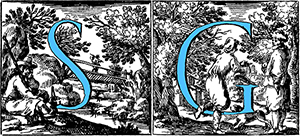It is well know that Francesco Mazzola, named as Parmigianino, was among the first to use the techinique of etching on copper plate (previously used on iron plate by Daniel Hopfer), main technique for the entire baroque during the seventeenth century. Before the middle of the sixteenth century too, F. Mazzola was the author of a very few number of etchings, full of grace and spontaneity.
During the sixteenth century, the use of this technique was expanded in France by the school of Fontainebleau engravers’, including Antonio Fantuzzi from Trento and Lèon Davent.
In the first part of the seventeenth century also others famous artists in Italy like Annibale and Ludovico Carracci, Federico Barocci, Guido Reni, José de Ribera or later Salvator Rosa, produced copper etching masterpieces.
In addition to painters-engravers (better known as “peintre-graveur”) that left us beautiful etchings, also some “pure” engravers like Jacques Callot and Stefano Della Bella (the first was born in France, but active mainly in Florence and Rome, the second insteat, was born in Florence, but for long time active in Paris) engraved masterpieces of unmatched technical skill and imagination about the subjects.
In detail, Della Bella is considered by the studious, the most representative and prolific Italian engraver of the seventeenth century. He was a skilled artist and his work-subjects moved from seascapes to the shows and parties of the Medici court, including also hunting scenes or grotesque decorations.
The etchings of Castiglione Genovese, named also “Grechetto”, are full of contrasts, reach in feeling and brightness. Probably, he was the most gifted engraver as the most characteristic of all the Italian artists during the seventeenth century. Inspired by Rembrandt work’s (as Rembrandt was influenced by the etchings style of Castiglione) he dealt with the most diverse subjects: biblical representations, landscapes, animals, oriental portraits and especially fantasy varieties that will be proposed again during in the eighteenth century in the works of Tiepolo.
All the lightness and airiness of the graphic style typical of the Baroque period can be see in the beautiful engravings by Simone Cantarini, named “il Pesarese”. He artistically developed himself in Bologna in the school of Guido Reni and he managed to develop a very personal technical language, characterized by the simplicity of composition and immediacy in expression.
The revival of classical themes was refreshed in Rome through the etchings of Pietro Testa, named the “Lucchesino”, characterized by a very refined and imaginative style. In his works, of high technical and compositional quality, exude the charm of classical culture, already resumed in the paintings of Poussin viewable in Rome.
In Naples, the printing of “invention” reached the highest levels with the exceptional works of Salvator Rosa, for him the technique of etching become the favourite means for his artistic expression. He was the undisputed protagonist of the Neapolitan engraving during the seventeenth century and he also was undoubtedly the “peintre-graveur” most imitated of all time.
XVII Century
The Italian Baroque
The seventeenth century in Holland
In Holland the seventeenth century was the golden century of etching. With the spreading of etching, the burin technique loses interest because, following the line suggested by Goltzius, this technique was essentially limited to the works of “reproduction”.
Great painter, Harmensz van Rijn Rembrandt is perhaps even more appreciated as engraver, unsurpassed master in the use of the etching admirably complemented by the burin and particularly by the drypoint. Through the production of about 400 plates he created a new graphical language, able to reach a technical perfection and an expressive power, unsurpassed before and after him. His technical ability allowed him to harmoniously combine different type of intaglio techniques creating unparalleled masterpieces.
The Rembrandt’s etchings retain its sketch vitality and the particular charm of unfinished works. In many of his works the brightness that appear from the darkness, creates almost a supernatural image. For this reason Rembrandt has been named as “the Master of light”.
Ferdinando Salamon wrote: “There were in the history of engraving other great figures such as Mantegna, Dürer, Goya; but Rembrandt is unique, lonely and distant, without the possibility of comparisons, above all”
Rembrandt did not have masters, he never made a trip to Italy, territories that at those time was right for every artist, he has never shown interest in Renaissance classical models. His neighbour, his land, his wife Saskia and the Bible were all his world, everything has to be near or around him.
While other masters painted the rich, shining and tidy Holland of the XVII century (mentioned in the Netherlands as the “golden age”) instead he was able to penetrate things in their essence, the intimate of men, to seize the moment and in the mean time to grasp the eternity.
Also the painter Adriaen van Ostade dedicated himself to etching. He was inspired in his early works, by the example of Rembrandt. Subsequently he reflected the influence of Callot, realizing picturesque interiors, rural life and genre scenes from popular setting. Van Ostade brugh the distanced, from the depths of the work of Rembrandt, but he has gained a quite personal touch for the particular realism of his etchings, making it one of the happiest and liveliest artist, representing of everyday life. He has started a long tradition in the Netherlands of engravers representing genre scenes so alive. This tradition has been brought on, in a smaller extent, by Cornelis Bega.
Quite active were also the group of engravers landscapers and animalist well represented by the works of Berchem, Visscher and Waterloo.
This latter artist has produced highly valuable etchings of rural and forested setting where the vegetation, represented with great skill, often has the upper hand on the rest of the composition.
Type a name or search alphabetically

